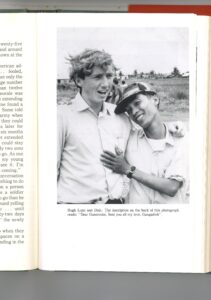The Day the War was Lost
by Hugh Lunn
Published The Australian 31 January 2018
Fifty years ago today – also a Wednesday – I set off early for my first reporting assignment of the day when my boss, perhaps feeling belatedly guilty, called out from his desk: “And Hugh, watch out for the sniper across the road.”
I had been in Vietnam for the last 12 months, going out in “the field” — Dak To, Con Thien, Loc Ninh, Gio Linh, Dong Ha, Ban Me Thuot, the Hiep Duc Valley and all those places that were dangerous back then — looking for war stories for London’s Reuters Newsagency.
But sometimes the war comes to you.
Late the previous evening, I’d been chatting to a friend in the Reuters office at 15 Han Thuyen Street, leaning against the always-open wire grenade-guard door, trying to keep cool.
Our Vietnamese reporter, Dinh – we called him Gunga Dinh because he was a better man than any of us – had been unusually quiet. Eventually, he stood up from his desk and approached us: “Gunsmoke, tell Miss go home.” Surprised, I said she was waiting for me to finish work.
“She go home…. Tonight the VC attack Saigon,” Dinh replied sternly.
My friend, who worked at the British Embassy, scoffed at such a ludicrous idea. The VC hadn’t got within cooee of Saigon before, and now there were more than half a million US troops “in country”. Still, I had to trust Dinh. Miffed, she jumped in her little white Mini and drove off.
I queried Dinh about his source. We had become close mates over the last year, but he was adamant: “No source. No background. No report… But must be ready. First with big story.”
Our Bureau Chief, Scotsman Jim Pringle — veteran of so many wars that Reuters said they wouldn’t bring him back to London in case war broke out — lived above the office. I called him down and he stood silent, staring straight ahead through his Coke-bottle-thick glasses, pink lips pursed.
Pringle said there had been no whisper of this from anyone else – in fact we were in the middle of a 36-hour truce. But we would have to act as if Dinh were right.
Dinh said they would attack at 1 a.m. He would go home to his family and be back then.
With a few hours to kill, so to speak, Jim Pringle and I walked down the main Tu Do Street to the New York Times office to tell them – hardly believing it ourselves. Journalist Tom Buckley got beers out of their fridge – he decided we needed a drink.
After midnight we walked back to the office even though it was after the curfew. As we strolled alone in the hushed dark – silent enough to hear a bullet drop — I knew Dinh was wrong. If something were going to happen surely the Americans, with 10,000 intelligence people in Vietnam, would know? They kept saying the tiny base of Khe Sanh way up north was under threat. Surely they would know if Saigon was?
Back at the office Pringle rang Dinh and suggested maybe he should wait, and when Dinh agreed, our last nagging doubts disappeared.
About 2 a.m., with Saigon deathly quiet, Pringle dropped me off at my friend’s unit block two miles away and I patched things up with the girl in the white Mini. Suddenly, gunfire outside, then explosions shook the building and she turned and said matter-of-factly: “It’s started, hasn’t it?”
Then a claymore mine blew up the Philippine Ambassador’s house next door. I could see VC emerging from manholes to attack the US Transport Depot opposite. Her Embassy flatmate appeared. Crying.
I had to get back to Pringle and the office: but no chance. So the three of us sat on the bathroom floor and listened to the fighting which didn’t cease for a moment. At first light I jumped in the white Mini and drove along deserted roads.
“It’s been terrible Hugh,” were Pringle’s first words, and I realised what was upon us. He was tired, exhilarated and, if it were possible, scared.
Jim Pringle had been up all night and saw bullets bouncing off the footpath outside. He had to telex his own stories because our Vietnamese telex operator wouldn’t come out from under the stairs… but he did light shaky matches so that Pringle could write his despatches on the floor.
After years of Washington saying they were getting closer and closer to winning the war – “he’s hurting” “the light is at the end of the tunnel” “we’re over the hump” – suddenly the Viet Cong were, for the first time, fighting in the very centre of Saigon.
They’d even broken into the American Embassy: a street from our office.
This Embassy was surrounded by a high reinforced-concrete wall, 24-hour guard boxes outside, huge steel spiked gates, US Marine guards inside. The entire six-storey building was covered in a chalk-white grill-patterned protective masonry façade.
Thus did the Americans call it “Pentagon East”.
Yet a hole had been blown in the wall and 19 Viet Cong guerrillas in black pyjamas were inside. The thick tall timber doors had been blown apart by an anti-tank rocket; the round emblematic Seal of the Embassy at the entrance had been shot up and lay on the foyer floor.
As I cut through the park to get to the Embassy side of the road I could have been off for a stroll in my shirt-sleeves on a warm post-dawn morning under a clear blue sky… except for the explosions and gunfire.
When I rounded the red brick Catholic Cathedral dominating Saigon’s main Tu Do Street I viewed the wide road outside the Embassy. It looked like a movie set. A 1950s black Citroen was riddled with long rows of bullet holes running along the side. Not far away was an American Military Police jeep, its windscreen shattered by bullets. Opposite the Embassy, behind every tree, American troops in flak jackets, some still in their pyjamas, lay prone as they aimed their M-16s and fired at their own Embassy.
Except for the sniper, who was in a partially-constructed building away to the right, the Embassy side of the road was the safest place to be. I crept past MPs reloading rifles from tins of bullets.
Nearby two of them lay dead face down on the road.
As I reached the driveway entrance to the Embassy – whose steel gates were now open — the street went quiet as if the movie projectionist had turned off the sound.
Against my wall adjacent to the shot-up Citroen, a cluster of American soldiers peeped around the corner into the driveway, rifles raised from the elbow, safety catches off. One of them was surprised to see me. “Get out of this area,” he ordered, “there are VC everywhere! And snipers! And mines!”
Gunfire got everyone’s attention. One of our group – the biggest of them – picked up an M-60 30-calibre machine-gun (something I would not have been able to lift) with its belt of ammunition touching the footpath and, firing from the hip, dashed through the gates saying “I’m going in to get those motherf..kers”.
He didn’t make it far because I could see his boots on the ground. Other US soldiers shot their way in to drag his body back out and he lay dead next to me on the pavement while gunfire went on around us to no apparent avail. The US Embassy was too well fortified to be readily re-taken.
I rushed back to the office to send a story to London: the Viet Cong were fighting the war on American soil for the first time. They controlled the first five floors of the Embassy building – three Marine guards, two of whom were wounded, were still holding the top floor.
And it wasn’t even breakfast time.
By now Pham Ngoc Dinh had reached the office – a hazardous thing for a Vietnamese civilian to do – and Dinh returned to Pentagon East with me. As we crept along the wall something completely unexpected happened. A hyped-up US soldier swung his M-16 around with his finger on the trigger and pointed it directly at Dinh shouting “OK Charlie”.
I thought he was going to shoot Dinh but, even so, I was speechless.
The quick-thinking Dinh raised his hands and said: “Not Viet Cong. I number one anti-communist”. With a perplexed look on his face the American returned to the battle. But, as Dinh later remarked: “How he really know? Cannot.”
As we reached the Embassy four American soldiers were bringing out a captured guerrilla. Each pointed his rifle into the man’s back. As he walked past us, hands in the air, his look of defiance contrasted with the contorted looks on the faces of the fighting four as an officer yelled at them repeatedly not to shoot.
As more and more Americans shot their way into the Embassy grounds, a helicopter finally managed to land reinforcements on the rooftop helipad and, with the Marines, they fought their way down.
After sending more stories, Dinh and I once again ventured back to the Embassy: the 19 Viet Cong in the suicide squad had been killed or captured. Dinh pointed at two of their bodies and remarked that they wore white shirts beneath their black clothes – and jewellery.
“Not Viet Cong peasants. Saigon underground man. Show way,” he said.
That Wednesday morning, in almost all cities and towns in South Vietnam, battles were being fought as part of the panoramic Communist Tet Offensive. Elsewhere in Saigon the VC were fighting in a factory, in a graveyard, in an uncompleted central city building, in the Chinese quarter of Cholon… even at the racetrack.
But none of that mattered. It was the capturing of Pentagon East that gained the attention of the world. At that moment, on that morning 50 years ago today, the people of America stopped believing their politicians. They now knew the USA was losing a war for the first time.
In a matter of weeks the US military commander for the last four years, General Westmoreland, was withdrawn; followed quickly by President Johnson’s announcement that he would not seek nomination for a second term as President.
As The Australian noted after the War: “The Tet Offensive of 1968 stood at the very epicentre of US experience in Indo China. Before Tet all was build-up and optimism. After Tet, all was withdrawal and recrimination.”
Hugh Lunn is the author of Vietnam: A Reporter’s War (HarperCollins)





